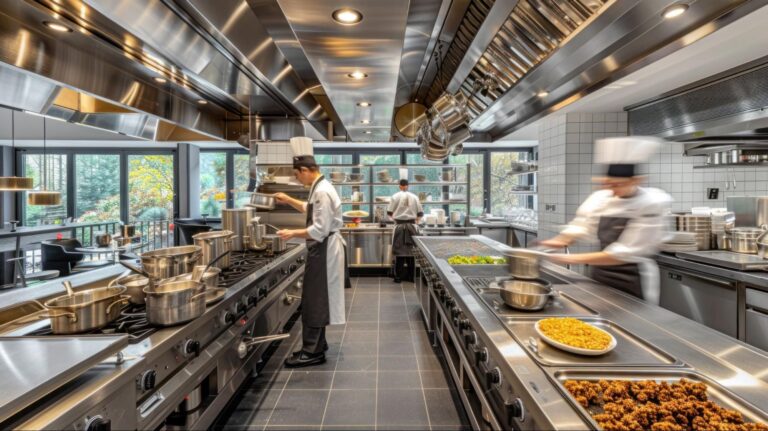Equipping a restaurant requires a substantial investment, whether it’s for ovens, refrigeration units, or display cases. For many restaurant owners, financing options become essential to bridge the gap between budget limitations and the high-quality equipment needed for efficient operations.
Navigating various financing options can be overwhelming due to the differences in terms, interest rates, and eligibility criteria. By learning how to compare restaurant equipment financing options effectively, you can make informed choices that support your business growth and financial stability.
This guide will walk through the major factors in evaluating financing options, covering types of loans, lease agreements, interest rates, and the pros and cons of each method.
Types of Financing Options for Restaurant Equipment
When you compare restaurant equipment financing options, several types of options are available, each with distinct terms and benefits. Here’s a breakdown of some of the most common types:
Equipment Loans
Equipment loans provide a lump sum of cash upfront to purchase the equipment outright. The equipment itself serves as collateral for the loan. It often requires a down payment, and the borrower is responsible for maintenance and repair costs.
Equipment loans are also ideal for business owners who prefer to own the equipment and can manage a longer-term payment commitment. However, if resale value and equipment depreciation are the concerns, other options may be more advantageous.
Rent-Try-Buy Programs
Rent-try-buy programs are tailored for restaurant owners who wish to test equipment before fully committing. In this arrangement, the business rents the equipment, with an option to buy it after a trial period. This option is perfect for restaurateurs who are uncertain about the specific equipment they need or may want to test newer models without committing to a purchase.
Lease Agreements
With a lease agreement, the equipment is rented for a specific period. At the end of the lease, business owners may have the option to buy the equipment at a discounted rate, renew the lease, or return the equipment.
Leasing can be a strong choice for startups or businesses that want flexibility in upgrading equipment as technology evolves. Leasing allows for predictable monthly costs and provides potential tax advantages, as lease payments may be tax-deductible.
Line of Credit
A line of credit allows businesses to borrow up to a specified limit, paying interest only on the amount used. It can be used for various expenses, including equipment purchases. Lines of credit are also best suited for established restaurants with ongoing financing needs beyond equipment, which provides flexibility without a rigid repayment schedule.
Key Factors to Compare When Choosing Equipment Financing
Each financing type has unique aspects that suit different business situations.
To choose the best option, you should evaluate the following key factors:
Interest Rates and Total Cost of Financing
Interest rates vary significantly based on creditworthiness, lender type, and financing term. Lower interest rates typically make equipment loans more affordable in the long term, but the total cost of financing also depends on additional fees, monthly payments, and penalties. Leasing and rent-try-buy programs may also have higher monthly payments, but they might offer lower initial costs compared to loans.
Ownership and Flexibility
Ownership structures differ across financing options. Equipment loans lead to ownership, which is beneficial for owners who plan to use the equipment long-term. In contrast, leases and rent-try-buy arrangements offer flexibility without ownership, which can be advantageous if business needs change or if equipment technology evolves quickly.
Down Payment Requirements
Certain financing options, such as equipment loans, may require a down payment, between 10-30% of the equipment cost. For cash-strapped businesses, lower or zero down payment options like leasing may be preferable.
Tax Implications
Equipment financing options offer various tax benefits. Loan payments generally provide tax benefits through depreciation of owned equipment. Lease payments, on the other hand, may be fully tax-deductible as operating expenses. Restaurant owners should also consult with a tax professional to understand the specific implications for each financing choice.
Maintenance and Repair Responsibilities
Ownership through a loan typically makes the borrower responsible for maintenance and repair, which can add costs over time. Leasing and rent-try-buy options may provide maintenance as part of the agreement, which can save money and hassle.
How to Choose the Best Financing Option for Your Restaurant
Choosing the right financing option depends on balancing your restaurant’s current cash flow, long-term goals, and the type of equipment and cooking tools needed.
Here’s a step-by-step approach to guide your decision-making:
Assess Your Financial Position
Calculate your budget and cash flow projections to determine what monthly payment you can comfortably afford.
Evaluate Equipment Lifespan
Consider the longevity of the equipment. For long-lasting assets, loans may be more cost-effective, while leasing or rent-try-buy options can be ideal for high-turnover equipment.
Seek Flexible Terms
Look for financing programs that offer flexible end-of-term options, like rent-try-buy, which allows for adjustments based on business performance and future needs.
Research Lender Reputation
Research reviews and ratings for financing companies, especially if considering a third-party lender. Reliable lenders can provide transparent terms and flexible policies.
Conclusion
Deciding on the best restaurant equipment financing option requires a comprehensive assessment of financial flexibility, equipment durability, and future needs. By keeping the information mentioned above in mind, you can secure financing that aligns with both short-term operational needs and long-term financial health.



